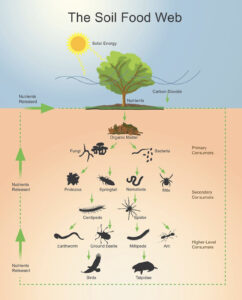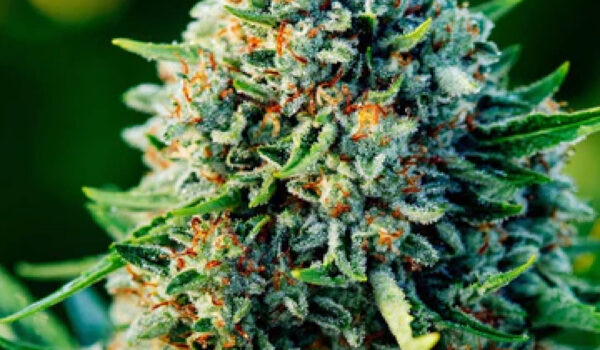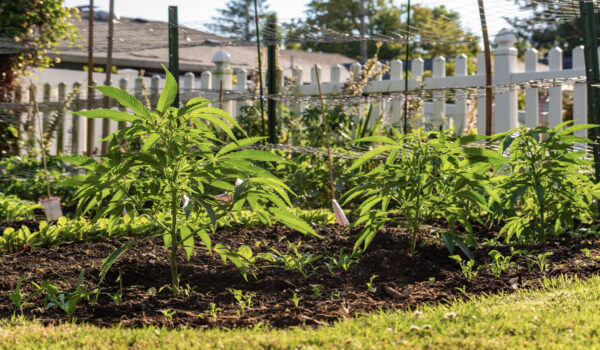
The Soil Food Web (SFW) is an amazing thing to understand because it helps us see the beautiful complexity in nature. Without a doubt, it’s not a simple straight line like a food chain is. In a chain we can easily track the energy from grass to cow to human. In the SFW there are a lot more complicated relationships between organisms that live and thrive in the soil. It’s also complicated by the fact that these relationships can change depending on the plant’s needs. I hope my explanation of the soil food web helps you understand it a little bit
Plants: The first thing I had to wrap my mind around was the part plants play in all this. Most of the energy being pumped into the soil food web was made from plants photosynthesizing sunlight. Scientists believe that plants use up to 20% of their photosynthetic energy, combined with minerals and CO2 to make organic compounds called exudate (Exude: To discharge, secrete or emit). These exudates are mostly sugars, simple starches, amino acids and have a complicated relationship with the soil’s microbial life. These exudates are secreted into the soil’s rhizosphere through the roots (Rhizosphere: the millimeters of soil surrounding a plant root where complex biological and ecological processes occur). One of the jobs for exudates are as chemical signals that plants release if they are under attack. The hope is that the exudate will attract a bacteria or fungus that will kill whatever is attacking it.
Bacterias are considered primary decomposers of organic material which break down and digest dead plant matter and they love to feed on plant exudates and dead root cells. Bacteria help feed both the plant and other life. All the organic material that they eat gets pooped out as plant available nutrients. Then all the nutrients and carbon that’s stored in their bodies is also turned into plant available nutrients when they are eaten by nematodes and protozoa then pooped out.
Mycorrhizal Fungi (mycorrhiza) are found in all soil where plants grow and it’s estimated that about 80% of all plant species form some type of association (mycorrhizal associations) with these fungi. This is a kind of symbiotic relationship because the fungi will give up water, enzymes and nutrients in exchange for plant root exudates. These specialized fungi colonize plant roots and extend far into the soil. Mycorrhizal fungal hyphae in the soil are true extensions of root systems and are more effective in nutrient and water absorption than the roots themselves. Think of mycorrhizal fungi as a large network of very fine plant roots. Even though they’re not roots, they behave in very similar ways. They tunnel into the nooks and crannies in the soil and collect water and nutrients for the plants. They effectively extending the root zone of the plant with long hyphal strands that thread their way through the soil. These strands also help soil structure, sticking soil particles together and making pathways for air and water. As the numbers of mycorrhizal hyphae spread into the surrounding soil, larger soil predators increase because of the increased fungal populations.
Protozoa (amoebas, paramecia, rotifers, flagellates) are single celled non-fungal, non-algal organisms that eat bacteria and fungus . They will graze along the edges of the bacteria encrusted roots and release the stored nutrients in the bacteria as excrement (poop, waste) in a plant-available form along the root zone. This is how they also help keep bacteria numbers in balance. The protozoa also help to control nematode populations, both by preying on them and by competing for resources. At the same time they will also be a food source for predatory nematodes as well. Protozoa also need a moist, well aerated soil in order to thrive and healthy numbers of protozoa are necessary for a healthy earthworm population. A strong protozoa population will also help regulate soil pH.
Nematodes are tiny roundworms with lots of different jobs. Some species are known to feed on plant matter, bacteria and fungi. Other nematodes are predators and will eat protozoa, other nematodes, grubs and small soil-dwelling pests. As nematodes travel through the soil, eating and pooping, they release nutrients in the root zone and help transport bacteria to different parts of the soil. This movement helps increase fungal activity which speeds up the breakdown and decomposition of organic matter. Nematodes need porous, moist soil to move around and will die off if the soil becomes dry and over-compacted.
Soil arthropods like woodlice, mites, ants, termites and springtails are known as “shredders” because they shred organic matter while feeding. For example, they will skeletonize fallen leaves, shredding them into smaller pieces that bacteria and fungi in the soil can use for food. Don’t forget that the poop from these shredders will also become food for bacteria and fungi. This decomposition improves the soil and increases microbial activity by spreading nutrients and bacteria around in the rhizosphere.
Earthworms are easily the biggest superstar of the soil food web because of the different parts they play in it. While their most important job is moving and aerating the soil, they also help with the shredding and ingesting of organic matter. As they move through the soil they’re providing food for fungi and bacteria as well as spreading their nutrient, mineral, enzyme and microbe-rich compost (poop). Earthworm compost improves soil structure, fertility, drainage, and balances soil pH. That compost also adds organic matter (50% more) and increases CEC (Cation Exchange Capacity – the soil’s ability to store nutrients). The enzymes that are made by bacteria in the worm’s gut are able to break down chemical bonds that release more plant-available nutrients into the soil. Up to 10x more phosphorus, 7x more potassium, 5x more Nitrogen, one and a half times more Calcium as well as other macro and micro nutrients and minerals are released. A healthy worm population needs a lot of organic matter, healthy microbial life and sufficient air and moisture in the soil to thrive.
Now this system doesn’t end with earthworms, it continues with bigger predators eating smaller prey. I’m going to stop right there because I don’t want to get lost in the “weeds”. I guess the main thing to understand about the soil food web is that every time something smaller is eaten and pooped out by something bigger, our plants and vegetables are getting fertilized. So like I said, I hope this explanation helps bring this system into a little clearer focus for you.
Grow Learn Teach
NOTE: I am not a soil scientist or any other kind of scientist. I used different internet sources to put this together. If you want more detailed information about this topic, please visit the sources below.
– Exudates: https://www.annualreviews.org/doi/full/10.1146/annurev.arplant.57.032905.105159
– Soil Food Web: https://www.nrcs.usda.gov/wps/portal/nrcs/detailfull/soils/health/biology/?cid=nrcs142p2_053868
– Soil Food Web: https://www.alchimiaweb.com/blogen/soil-food-web/
– Soil Food Web: https://www.grow-it-organically.com/soil-food-web.html

